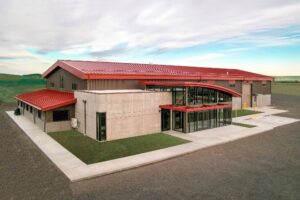
Building officials benefit from IAS AC472 and AC478 in low-rise construction
![]() It is common for building officials to hone in on the inspection of high-rise structures to ensure absolute safety in design and construction. But officials must also carefully inspect low-rise structures such as strip centers, warehouses and manufacturing facilities. When focused on the low-rise construction market, building officials can benefit from knowing about specific accreditation programs from the International Accreditation Service (IAS).
It is common for building officials to hone in on the inspection of high-rise structures to ensure absolute safety in design and construction. But officials must also carefully inspect low-rise structures such as strip centers, warehouses and manufacturing facilities. When focused on the low-rise construction market, building officials can benefit from knowing about specific accreditation programs from the International Accreditation Service (IAS).
About the International Accreditation Service
To provide some background, IAS has been providing accreditation services since 1975. Originally, the services provided by IAS were part of the former model code organizations (BOCA, ICBO, SBCCI) that became the International Code Council. When those organizations formed the Code Council in the early 1990s, IAS was created as a separate nonprofit accreditation service. IAS is a subsidiary of the Code Council and one of the leading accreditation bodies in the United States. IAS is a signatory to the three primary international organizations that form a unified system for evaluating and recognizing competent accreditation bodies worldwide. IAS undergoes periodic onsite evaluation to determine ongoing compliance with ISO/IEC Standard 17011, General Requirements for accreditation bodies accrediting conformity assessment bodies.
Accreditation programs
The accreditation programs offered by IAS provide verification that companies or organizations have demonstrated compliance with accreditation criteria, standards and codes. The programs are developed and maintained with input from industry and regulators. Maintaining accreditation is subject to periodic assessments by IAS.
IAS provides two major accreditation programs that support building departments and industry professionals involved with the design, fabrication, installation, inspection and approval of engineered metal building systems.

The IAS Metal Building Systems Inspection Accreditation Program, also known as AC472 which is the accreditation criteria used to assess companies, audits the integrity of design engineering and manufacturing processes in metal building manufacturing facilities. IAS AC472 is the program to accredit the metal building manufacturers’ inspection program. The program is based on the requirements in Chapter 17 of the International Building Code (IBC) for special inspection of fabricated items (Section 1704.2.5) and fabricator approval (Section 1704.2.5.1). Therefore, building officials can accept IAS accreditation as sufficient evidence that manufacturers have demonstrated effective implementation of a documented inspection program and are in compliance with those requirements of the International Code, eliminating the need for redundant in-shop inspections because AC472 attests the fabricator’s inspection program is implemented and documented to assure the fabricated members and components quality is built into the final construction according to approved plans.
While AC472 applies to design, fabrication and inspection of the engineered metal building system before it arrives on the job site, IAS offers the Metal Building Assemblers Inspection Accreditation for companies that do the onsite assembly of metal buildings. This program is known as IAS AC478, the accreditation criteria developed by IAS to assess companies.
At the construction site, a building official can also reduce redundancy when observing a construction team whose standards and practices have been vetted through inspections required by AC478, the Inspection Practices of Metal Building Assemblers. It is the recognized benchmark for best practices for the inspection of metal building assemblers and is provided for all companies qualified to assemble metal buildings.
Both accreditation programs (AC472 and AC478) are recognized as a measure of quality endorsed by the Metal Building Contractors and Erectors Association, the North American Iron Workers/IMPACT Labor-Management, the Metal Building Manufacturers Association (MBMA) and the International Code Council.
“We see building owners and contractors using metal buildings for their affordability, efficiency in construction and precise engineering as they are manufactured. IAS adds reassurance for building officials and building departments who focus on code-compliant structures utilizing the IAS accredited programs,” said Selso Mata, chief building official in Plano, Texas. “Our approval process is much smoother because the IAS accreditation of the metal building manufacturers inspection program, AC472, combined with the IAS accreditation of the assembly of those metal buildings, AC478, aligns and assists us with our approval process. Our building department appreciates the professionalism and technical expertise IAS accreditation adds to our process.”
Benefits to a building department: AC472
Benefits to the building official include:
- By requiring IAS AC472 accreditation, the building official can easily confirm the manufacturer is in compliance with the requirements in Chapter 17 of the IBC.
- The building official can be assured that suppliers have passed stringent audit requirements.
- Allowing only accredited metal building manufacturers to help protect the building official’s goal of guaranteeing that a competent and committed audited supplier is on the project.
- Accreditation requires that the manufacturer only use raw materials meeting applicable ASTM specifications.
- Since the IAS-accredited organization is performing the structural design, accreditation assures that the product is being designed by professional engineers who have demonstrated knowledge of building systems and applicable codes.
- Accreditation requires that all Letters of Certification, design calculations and drawings be clearly communicated and stamped by a fully qualified professional design engineer licensed in the state in which the building is being assembled.
“AC472 is so important to the integrity of our industry that all metal building manufacturers who wish to be affiliated with MBMA must become accredited to even be considered for membership,” says Tony Bouquot, general manager of MBMA.
Benefits to a building department: AC478
Building officials gain a layer of protection for their jurisdictions when buildings are being assembled by companies accredited through AC478. When a firm is evaluated for accreditation, attention is focused on assembly procedures, inspections, quality assurance, training regiments and commitment to safety. In fact, accredited companies must have a safety plan and a job safety analysis risk assessment tool to identify and control workplace hazards. Each accredited firm must provide:
- A description of procedures and policies that ensure the safety of all people.
- A safety manager whose experience confirms his or her competence and who demonstrates consistent results in establishing, maintaining and implementing a safety program.
- An assurance that the safety manager has direct access to the firm’s top executives.

“When accreditation inspectors verify people at a site-specific location, they are stringent in evaluating skills and knowledge,” says Walter Mershon, senior technical assessor, IAS FA-MB-MBA programs. “They verify who inspects bolts and who welds joints; they verify that the people performing the work are properly trained to do it.” Mershon also explains that to qualify for accreditation, firms that assemble metal buildings must demonstrate that they have the personnel, organization, experience, knowledge, management procedures and commitment to assemble metal building systems in a safe manner.
Not only does AC478 benefit the building inspectors but it also makes constructors both accountable and responsive. This was clear from a conversation with Dale Heck at The Kaiser-Martin Group based in Temple, Penn. The firm erects steel buildings throughout the eastern U.S. “We understand the importance of AC478,” he says. “It allows us to pursue high-quality projects because major companies require it. Accreditation confirms to them that we have good, safe procedures in place and that we are accountable to high standards.” Heck says maintaining accreditation also helps the firm to continually improve and to stay current in its training programs. “All in all, it makes us a better company,” he adds.
Growing popularity, burgeoning reputation

While AC472 has been in place just a dozen years (and AC 478 less than half as long), both programs have proven to be respected and valued and influential throughout the construction industry. Today, some architects and engineers are requiring that the metal building system manufacturer be AC472 accredited right in their building specifications. “The Corps of Engineers and ARCOM (which publishes Master Specs for the architectural community) have also added accreditation language to their documents,” comments Steve Browning, president of Vulcan Steel Structures and current chairperson of MBMA. Building officials often follow up to be sure the metal building system manufacturing and design facilities are AC472 accredited and therefore in compliance with the special inspection requirements in Chapter 17 of the IBC. Some cities that have their own inspection programs, like Houston and Los Angeles, also recognize AC472 and so their city inspectors can often reduce their inspection load by simply confirming that a facility is accredited. In short, AC472 offers a credible, centralized, consistent set of public criteria guidelines that have gone through the public hearing process and achieved mainstream industry acceptance.” According to Mershon, a number of architects are now specifying that the building manufacturer be accredited to AC472 and the assembler be accredited to AC478 before being allowed to bid on a project.
Arthur Hance, president of Hance Construction in Washington, N.J., sums up the value of AC478 succinctly. “Our experience from achieving AC478 accreditation is that we have improved our order entry process, job site safety and quality of the finished structure. AC478 has had the added benefit of making our staff more focused on safety and quality in all aspects of our construction efforts. For the code official, AC472/478 accreditation means a building system that meets code guidelines from design and manufacturing through erection. Few if any other building systems can provide such assurance that building safety and quality are being met.”









